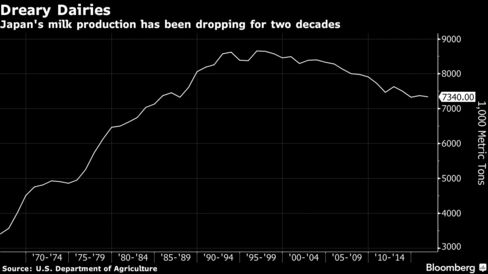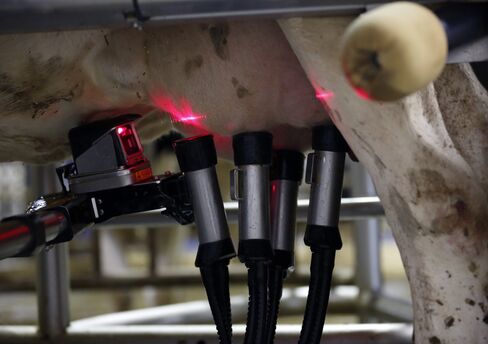Jin Kawaguchiya gave up a career in finance to help revive Japan’s ailing dairy industry — one robot at a time.
In a country that relies increasingly on imported foods like cheese and butter, Japan’s milk output tumbled over two decades, touching a 30-year low in 2014. Costs rose faster than prices as the economy stagnated, eroding profit, and aging farmers quit the business because they couldn’t find enough young people willing to take on the hard labor of tending to cows every day.
But technology is altering that dynamic. On the northern island of Hokkaido, Japan’s top dairy-producing region, Kawaguchiya transformed the 20-cow farm he inherited from his father-in-law 16 years ago into Asia’s largest automated milking factory. Robots extract the white fluid from 360 cows three times a day and make sure the animals are fed and healthy. The machines even gather up poop and deposit it in a furnace that generates electricity.

“Without robots, I would have to hire as many as 15 part-time workers to take care of cows,” Kawaguchiya, 44, said during an interview at the dairy in Kakuyama. “I can save 15 million yen ($146,000) a year thanks to them.”
Kawaguchiya had no experience in farming before taking over the farm from his father-in-law, whose three daughters weren’t interested in running a dairy that required them to manually attach milking tubes to the teats of each cows. Kawaguchiya says he quit a job as a manager in Tokyo for Shoko Fund & Co., a business lender, because he saw an opportunity to make a better living in agriculture, provided he could change the economics.
To add scale, he merged the farm with four nearby dairies to create Kalm Kakuyama, a stock company that now has 610 animals, including 380 cows purchased last year. About 250 are calves or pregnant females who aren’t producing milk for the dairy.

Automation has transformed the business. After investing 1.5 billion yen to install the robots and the 150 kilowatt per hour generator about 14 months ago, Kawaguchiya says his raw-milk production will quadruple this year from 2015 to 4,500 metric tons, and reach 5,600 tons next year, almost 10 times the output of the average dairy farm in Japan. He’s now the largest producer in western Hokkaido. With less time spent on manual labor, he can analyze data on milk output, quality and animal health to be more efficient.

Kawaguchiya isn’t alone. The island has more than 100 milking robots, according to Shinichi Otsuka, the head of the agricultural technology department at the Hokkaido prefecture government.
With bigger and more efficient dairies emerging in Hokkaido, raw-milk output is recovering. In the first half of 2016, production in Japan rose 1.1 percent from a year earlier to 3.78 million metric tons, heading for a second annual gain since touching 7.33 million tons in 2014, the lowest since 1984, according to the Agriculture Ministry. While the number of dairies continues to drop, the ones that remain are getting bigger and productivity per cow is increasing, the data show.
Mega Farms
“So-called mega farms are emerging in Hokkaido, increasing their presence in the Japanese dairy industry,” said Koichiro Omoto, head of the information planning department of Japan Finance Corp., a government-affiliated lender that boosted loans to dairies by 17 percent in the year through March.
Use of robots may spread faster in Japan than other countries because the industry — populated mostly with small family farms and aging owners — is faced with a labor shortage and needs to get more efficient, said Yoko Takeda, chief economist at Mitsubishi Research Institute in Tokyo.

The number of dairies has plunged 28 percent in the past eight years to about 18,000, Agriculture Ministry data show. Farmers in Japan are also getting older, with the average age last year at 67, compared with 63.2 in 2005.
“Young people are reluctant to take over their parents’ farms as they cannot see a bright future,” Kawaguchiya said. “Their earnings are very small compared with other jobs.”
Technology Investments
More investment in information technology is a key to enhancing productivity in agriculture, according to Yuji Yamamoto, selected by Prime Minister Shinzo Abe as agriculture minister when he reshuffled his cabinet on Aug. 3. Japan can sometimes face shortages of dairy products, with the country needing to import an additional 4,000 tons of butter to meet demand.
The government began subsidies for milking robots last year after signing the Trans-Pacific Partnership trade deal, which will mean cheaper dairy imports and more competition for domestic producers. The financial support expanded 12 percent this fiscal year to 68.5 billion yen, according to the Agriculture Ministry. Kalm Kakuyama took advantage of borrowing costs near zero percent to buy its robots. Money is cheap because the Bank of Japan is seeking to revive the stagnant economy with record monetary stimulus.
Robot Makers
More investment is good news for makers of milking robots, including DeLaval of Sweden, Lely Industries NV of the Netherlands and GEA Farm Technologies of Germany. Sales of milking robots in Japan will jump 67 percent this year from last year, after doubling in 2015, said Satoshi Shinya, director at the Tokyo office of DeLaval, which provides robots and related service to Kawaguchiya’s farm. The use of robotic systems may reach 30 percent of all dairy farms in Japan, compared with 2 percent now, he said.
“Sales are expanding as the government shoulders half of costs to introduce robots, and farms have difficulty finding cheap labor,” Shinya said. “As local dairy farms are under pressure from TPP, the government is boosting subsidy payments for them, which is positive for us.”

One robot can handle as many as 60 cows and produce 3 tons of milk a day. The traffic is managed by the machine, which uses cameras to identify each cow, find the nipples and disinfect them before milking, a process that can take less than 10 minutes.
“We want our company to be a core of economic activities in this community,” Kawaguchiya said. “Then we can find successors, either from our family members or outside.”
Source: Bloomberg











